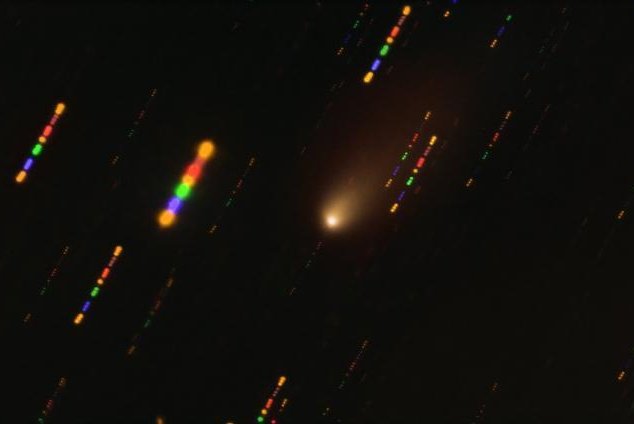Astronomers used the FORS2 instrument on ESO's Very Large Telescope to study the polarization of light passing through the trail of gas and dust left by 2I/Borisov as it passed near the sun. Photo by ESO/O. Hainaut
March 30 (UPI) -- Often, an especially long journey is visible on a traveler's face, but despite its trek from a distant solar system, 2I/Borisov, the world's first rogue comet, appears no worse for wear.
According to a new study, published Tuesday in the journal Nature Communications, 2I/Borisov is one of the most pristine comets scientists have ever observed.
First spotted by amateur astronomer Gennady Borisov in August 2019, 2I/Borisov became just the second interstellar object seen passing through our solar system. The first was 'Oumuamua, an ice-covered asteroid that looked a lot like a petrified Millennium Falcon.
By the time researchers first observed 'Oumuamua, the object was moving away from the sun. Luckily, astronomers and ALMA caught 2I/Borisov on its way toward the sun, allowing scientists to get a close look at the comet's composition.
With the help of the FORS2 instrument on European Southern Observatories's Very Large Telescope, astronomers used a technique called polarimetry to catalogue 2I/Borisov's optical properties.
Polarimetry involves the study of the way light spins as it is reflected, refracted or diffracted by or through materials -- like a comet's coma, the trail of gas and dust that emanates as the comet nears the sun.
Scientists found the comet's polarimetric characteristics were unlike those of 99 percent of comets in the solar system -- with the exception of Hale-Bopp.
When Hale-Bopp passed by Earth on its way toward the sun during the late 1990s, scientists estimated it was only the comet's second trip to the inner solar system.
In other words, Hale-Bopp was especially pristine, having been untainted by solar winds and radiation.
Comets, which spend the majority of their time frozen and far from solar radiation, preserve the materials from which the solar system was formed -- the gas and dust that condensed millions of years ago to form our sun and planets.
The fewer trips a comet has taken around the sun, the more pristine. Especially pristine comets, like Hale-Bopp, offer the clearest picture of what the solar system looked like in its infancy.
According to the FORS2 data, the rogue comet 2I/Borisov looks a lot like Hale-Bopp.
"The fact that the two comets are remarkably similar suggests that the environment in which 2I/Borisov originated is not so different in composition from the environment in the early solar system," study co-author Alberto Cellino, a researcher at the Astrophysical Observatory of Torino in Italy, said in a press release.
The survey of 2I/Borisov's trip through our solar system -- documented by both VLT and ESO's Atacama Large Millimeter/submillimeter Array -- revealed stark shifts in the ratios of carbon monoxide and water in its dust grains as the comet rounded the sun.
The observations suggest 2I/Borisov was formed by materials originating from both the inner and outer regions of its home solar system.
The comet's homogenous coma suggests that, since its formation, 2I/Borisov has remained untainted by radiation or any kind.
"Comet 2I/Borisov ... most likely never passed close to the sun or any other star, and may represent the first truly pristine comet that has ever been observed," researchers wrote.















